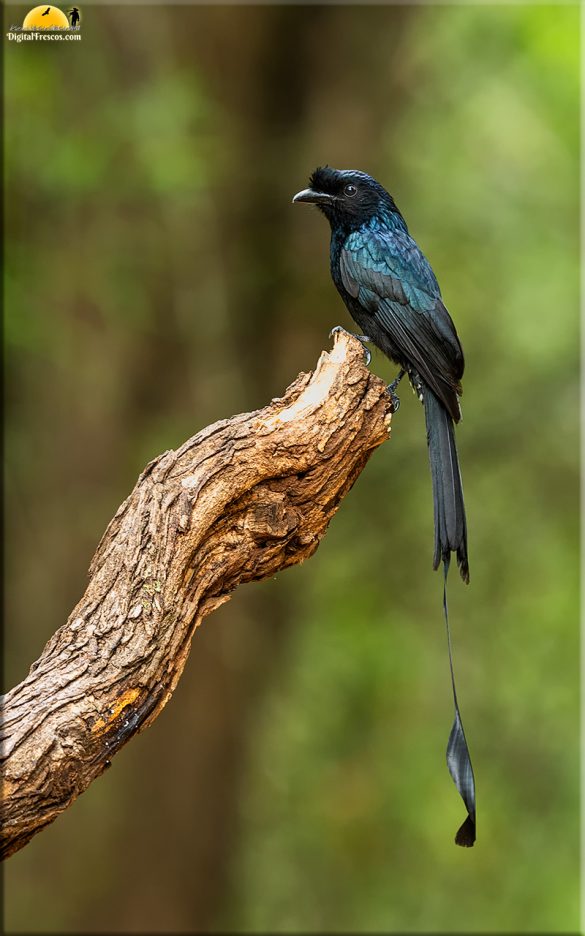
The greater racket-tailed drongo is a medium-sized Asian bird which is distinctive in having elongated outer tail feathers with webbing restricted to the tips. They are conspicuous in the forest habitats often perching in the open and by attracting attention with a wide range of loud calls that include perfect imitations of many other birds. One hypothesis suggested is that these vocal imitations may help in the formation of mixed-species foraging flocks, a feature seen in forest bird communities where many insect feeders forage together. These drongos will sometimes steal insect prey caught or disturbed by other foragers in the flock and another ideas is that vocal mimicry helps them in diverting the attention of smaller birds to aid their piracy. The distribution range of this species extends from the western Himalayas to the eastern Himalayas and Mishmi Hills in the foothills below 1,200 m (3,900 ft). They are found in the hills of peninsular India and the Western Ghats. Continuing into the west to the islands of Borneo and Java in the east through the mainland and islands. This species is classified as least concern by IUCN.
It is also called as Golden browed bulbul. An yellow and olive bird that has a distinct yellow brow and consequently the name. It is a forest canopy dwelling bird and found in the western ghats of India and Srilanka. They primarily feed on insects and berries, it is classified as least concern by IUCN.
White-cheeked barbet is also known as the small green barbet. It is again a forest dwelling bird found mainly in western ghats and adjoining areas. A predominant fruit eater which can use its bills to excavate the cavities in trees and where it nests. It is classified as least concern by IUCN.
A rather common dove found across India and south east Asia. Spotted Doves feed on grains, seeds and scraps. The birds are seen alone or in small flocks, feeding mostly on the ground. They were introduced to Australia in 1860s and have expanded their range across OZ. The species is found in light forests and gardens as well as in urban areas. They are classified as least concern by IUCN.
It is also called as the crested bulbul. This bird is found across Asia. It is one of the most common birds in urban gardens. This bird is a predominantly a fruit eating bird and is classified as least concern by IUCN.
The grey junglefowl also known as Sonnerat’s junglefowl, is one of the wild ancestors of domestic fowl together with the red junglefowl and other junglefowls. They are found in thickets, on the forest floor and open scrub. They feed on grains including bamboo seeds, berries, insects and termites. They are classified as least concern by IUCN.
One of my favourite raptors that you could easily spot in the winters alon the grasslands across the country.
A long cherished desire to see and photograph this marathon migrant was fulfilled in the last month of 2016. This small falcon breeds in Siberia during summer and winters in Africa. It is a passage migrant in India while going to or from Siberia. In Nagaland India where they congregate in huge flocks there was rampant hunting and killing of this cute insect eating falcon. Due to the efforts of the conservationists the situation has vastly changed.
A long cherished desire to see and photograph this marathon migrant was fulfilled in the last month of 2016. This small falcon breeds in Siberia during summer and winters in Africa. It is a passage migrant in India while going to or from Siberia. In Nagaland India where they congregate in huge flocks there was rampant hunting and killing of this cute insect eating falcon. Due to the efforts of the conservationists the situation has vastly changed.
A long cherished desire to see and photograph this marathon migrant was fulfilled in the last month of 2016. This small falcon breeds in Siberia during summer and winters in Africa. It is a passage migrant in India while going to or from Siberia. In Nagaland India where they congregate in huge flocks there was rampant hunting and killing of this cute insect eating falcon. Due to the efforts of the conservationists the situation has vastly changed.
A long cherished desire to see and photograph this marathon migrant was fulfilled in the last month of 2016. This small falcon breeds in Siberia during summer and winters in Africa. It is a passage migrant in India while going to or from Siberia. In Nagaland India where they congregate in huge flocks there was rampant hunting and killing of this cute insect eating falcon. Due to the efforts of the conservationists the situation has vastly changed.
The Lion tailed macaque is seen here feeding on one of its favorite food – Jack fruit. This high endangered monkey is a rainforest dweller and are found in the western ghat range and southern part of India – Tamil Nadu, Kerala and Karnataka.
We observed this gang of LTM just before we reached Valparai. They were gorging on Jack fruits from the trees on the rain forest by the side of the road and that is when this individual decided to come down and strike a pose with his tail up. The name Lion Tailed Macaque is because of the similar looking tail of the Macaque and the Lion.